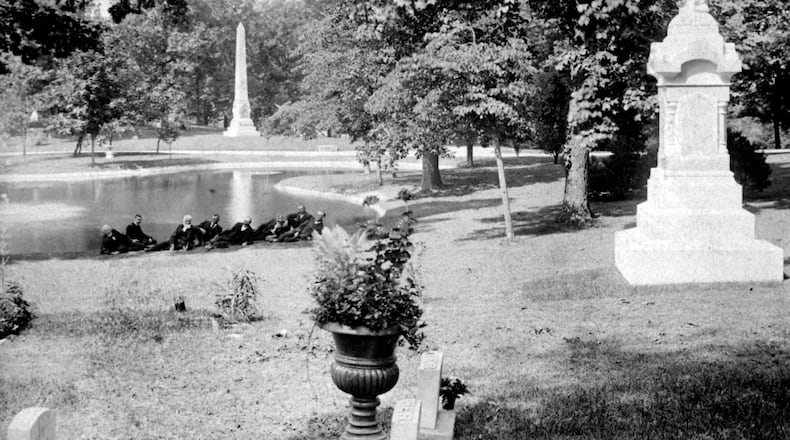John Van Cleve, who served as mayor of Dayton in the 1830s and was an advocate for beautifying the city, took on the job of identifying an acreage that would suit Dayton’s future burial needs. In 1841 the Woodland Cemetery Association of Dayton was formed.
A mile south of town, Augustus George owned 40 acres of uncleared land he was willing to sell for $60 an acre. The hilltop land offered an impressive view and was covered with a variety of trees. The site was named Woodland when it opened in 1843 because of its natural beauty.
“The Dayton community leaders in 1840 shared a remarkable vision and became early adopters of the rural cemetery movement and established what I consider to be one of the leading cemeteries in the country in terms of inspiration, history, beauty and significance,” Sean O’Regan, president and CEO of Woodland Cemetery and Arboretum, said.
The rural cemetery was a brand-new concept at the time.
“This was a significant shift away from burials on the grounds of a church, a town meetinghouse or even the early cemeteries that were located away from population centers due to public health concerns,” O’Regan said.
“The cemetery was a place to ‘talk’ to the deceased while honoring them with flowers,” according to Woodland Cemetery’s historical account, which went on to say that “family picnics were commonplace in large, park-like cemeteries.”
“The rural cemetery movement established beautiful park like settings in which to remember those that passed,” O’Regan said. “The early rural cemeteries pre-dated public parks, and thus they became a destination to enjoy the beautiful grounds, reflect and celebrate the life of those who had passed before us but also appreciate one’s life in the present.”
According to a description in research on Woodland Cemetery in the Wright State University archives, “By 1867, the grounds of Woodland Cemetery attracted many visitors. It was the place to go for a Sunday stroll. There were beautifully landscaped areas: flowers and ferns and great iron urns filled with exotic plants and wire and wrought-iron benches on which to rest and contemplate.”
The cemetery’s office, gateway and chapel, completed in 1889 in the Romanesque style, are on the National Register of Historic Places. The chapel houses 17 Tiffany windows in vibrant hues of green, blue and purple, a hand-cut Tiffany tiled floor and hand-painted Tiffany frescoes.
The cemetery has been the resting place for numerous early Dayton area luminaries, including Major David Ziegler, a Revolutionary War veteran and the first Mayor of Cincinnati, and George Newcom, one of Dayton’s early settlers who ran a tavern on Main Street.
Aviation pioneers Orville and Wilbur Wright, poet Paul Laurence Dunbar, inventor Charles Kettering and writer Erma Bombeck are also buried under the canopy of trees.
Today Woodland Cemetery & Arboretum encompasses 200 acres and is considered one of the oldest “garden” cemeteries in the nation, with more than 3,000 trees, many at least 100 years old, and 165 specimens of native Midwestern woody plants.
“Woodland has been entrusted with the care of over 108,000 souls and is still an active cemetery and will continue to be an active cemetery for at least another 100 years,” O’Regan said.
The cemetery plans to hold a formal celebration for its 180th anniversary later in the year when pandemic protocols allow. Donors who make a $180 contribution to the Arboretum Foundation to commemorate the year of incorporation will receive a set of Woodland ceramic coasters
About the Author





